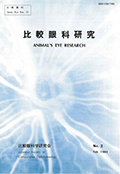Volume 2
Displaying 1-6 of 6 articles from this issue
- |<
- <
- 1
- >
- >|
Reports at Second Symposium on Some Problems in the Field of Comparative Ophthalmology
-
1983Volume 2 Pages 1-4
Published: 1983
Released on J-STAGE: December 25, 2020
Download PDF (1048K) -
1983Volume 2 Pages 5-9
Published: 1983
Released on J-STAGE: December 25, 2020
Download PDF (1461K) -
1983Volume 2 Pages 10-15
Published: 1983
Released on J-STAGE: December 25, 2020
Download PDF (1853K) -
1983Volume 2 Pages 16-20
Published: 1983
Released on J-STAGE: December 25, 2020
Download PDF (1221K)
Original Report
-
1983Volume 2 Pages 21-25
Published: 1983
Released on J-STAGE: December 25, 2020
Download PDF (1684K)
Bibliography
-
1983Volume 2 Pages 27-68
Published: 1983
Released on J-STAGE: December 25, 2020
Download PDF (10876K)
- |<
- <
- 1
- >
- >|
